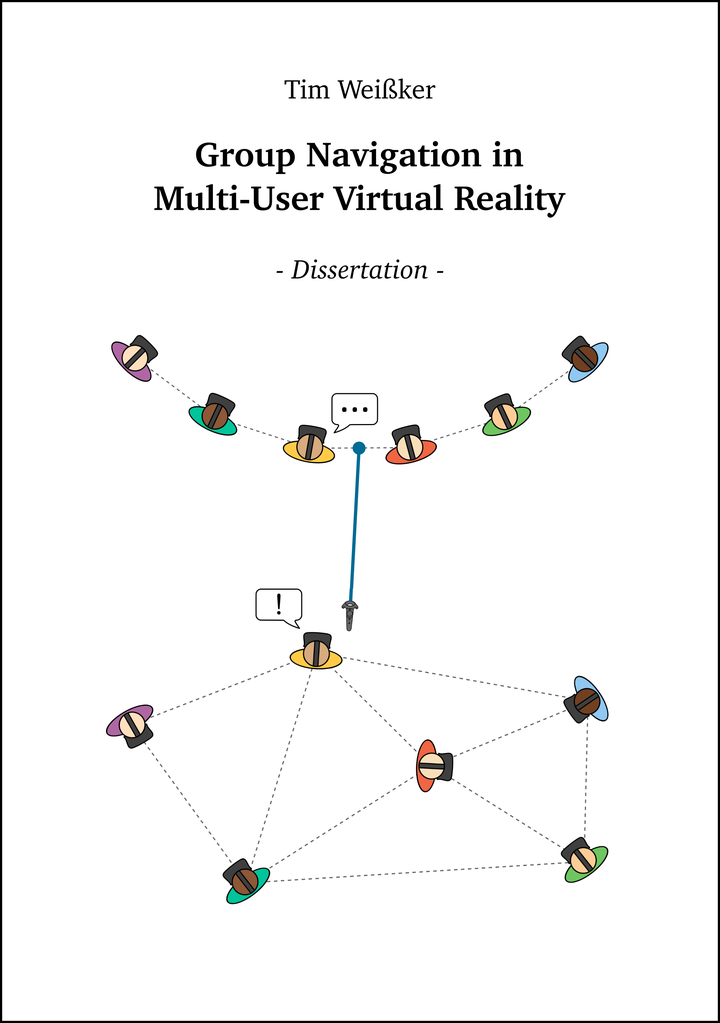
Abstract
Multi-user virtual reality systems enable collocated as well as distributed users to perform collaborative activities in immersive virtual environments. A common activity in this context is to move from one location to the next as a group to explore the environment together. The simplest solution to realize these multi-user navigation processes is to provide each participant with a technique for individual navigation. However, this approach entails some potentially undesirable consequences such as the execution of a similar navigation sequence by each participant, a regular need for coordination within the group, and, related to this, the risk of losing each other during the navigation process.
To overcome these issues, this thesis performs research on group navigation techniques that move group members together through a virtual environment. The presented work was guided by four overarching research questions that address the quality requirements for group navigation techniques, the differences between collocated and distributed settings, the scalability of group navigation, and the suitability of individual and group navigation for various scenarios. This thesis approaches these questions by introducing a general conceptual framework as well as the specification of central requirements for the design of group navigation techniques. The design, implementation, and evaluation of corresponding group navigation techniques demonstrate the applicability of the proposed framework.
As a first step, this thesis presents ideas for the extension of the short-range teleportation metaphor, also termed jumping, for multiple users. It derives general quality requirements for the comprehensibility of the group jumping process and introduces a corresponding technique for two collocated users. The results of two user studies indicate that sickness symptoms are not affected by user roles during group jumping and confirm improved planning accuracy for the navigator, increased spatial awareness for the passenger, and reduced cognitive load for both user roles.
Next, this thesis explores the design space of group navigation techniques in distributed virtual environments. It presents a conceptual framework to systematize the design decisions for group navigation techniques based on Tuckman’s model of small-group development and introduces the idea of virtual formation adjustments as part of the navigation process. A quantitative user study demonstrates that the corresponding extension of Multi-Ray Jumping for distributed dyads leads to more efficient travel sequences and reduced workload. The results of a qualitative expert review confirm these findings and provide further insights regarding the complementarity of individual and group navigation in distributed virtual environments.
Then, this thesis investigates the navigation of larger groups of distributed users in the context of guided museum tours and establishes three central requirements for (scalable) group navigation techniques. These should foster the awareness of ongoing navigation activities as well as facilitate the predictability of their consequences for all group members (Comprehensibility), assist the group with avoiding collisions in the virtual environment (Obstacle Avoidance), and support placing the group in a meaningful spatial formation for the joint observation and discussion of objects (View Optimization). The work suggests a new technique to address these requirements and reports on its evaluation in an initial usability study with groups of five to ten (partially simulated) users. The results indicate easy learnability for navigators and high comprehensibility for passengers. Moreover, they also provide valuable insights for the development of group navigation techniques for even larger groups.
Finally, this thesis embeds the previous contributions in a comprehensive literature overview and emphasizes the need to study larger, more heterogeneous, and more diverse group compositions including the related social factors that affect group dynamics.
In summary, the four major research contributions of this thesis are as follows:
- the framing of group navigation as a specific instance of Tuckman’s model of small-group development
- the derivation of central requirements for effective group navigation techniques beyond common quality factors known from single-user navigation
- the introduction of virtual formation adjustments during group navigation and their integration into concrete group navigation techniques
- evidence that appropriate pre-travel information and virtual formation adjustments lead to more efficient travel sequences for groups and lower workloads for both navigators and passengers
Overall, the research of this thesis confirms that group navigation techniques are a valuable addition to the portfolio of interaction techniques in multi-user virtual reality systems. The conceptual framework, the derived quality requirements, and the development of novel group navigation techniques provide effective guidance for application developers and inform future research in this area.